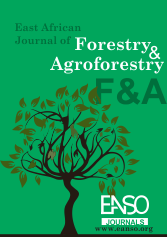Community Lessons on Participatory Forest Management Performance within the Mau Forest Complex, Kenya
Abstract
Forest resources are faced with challenges that range from mismanagement, overutilization, conflicts and competing claims. Consequently, this has given rise to legislation and policy to protect forests. However, many governments in developing countries have difficulties in implementing sustainable forest management (SFM). One of the strategies advocated to foster SFM is participatory forest management (PFM). The PFM approach has been practised formally in Kenya since 2005 when the Forests Act of 2005 came into force. The aim of this study was to assess PFM performance since the inception of three Community Forest Associations (CFAs), namely Nairotia, Nyangores and Olenguruone in the Transmara Forest Block within the Mau forest complex, Kenya. The data and information ranged from reviews from field meetings and in-depth focus group discussions with CFA members, Kenya Forest Service (KFS) officials and various key stakeholders. The results indicated that there are variations in results and progress towards PFM implementation in Kenya. While a number of activities had been carried out at each of the CFAs reviewed in the study, there was variation in terms of how the forest management agreements and plans were being implemented. In particular, the level of community and stakeholder participation, number of consultative meetings held and level of donor funding to facilitate participatory forest management plans (PFMP) development and project activities. A number of issues were also noted by CFAs as having been omitted in the management plans, specifically, benefit sharing. The absence of benefit sharing framework was cited often as a major drawback in PFM as it has constrained some of the anticipated benefits from forest activities. However, the community members indicated that there was improved awareness amongst them of the need to conserve the forest resources and controlled access to sustainable utilization of the forest resources
Downloads
References
Agevi, H., Wabusya, M., & Tsingalia, H. M. (2014). Community Forest Associations and Community Based Organizations: Redesigning their Roles in Forest Management and Conservation in Kenya. International Journal of Science and Research, 3, 1916-1922.
Agrawal, A., Chhatre, A., & Hardin, R. (2008). Changing governance of the world's forests. Science, 320: 1460–1462.
Ameha, A., Nielsen, O. J., & Larsen, H. O. (2014). Impacts of access and benefit sharing on livelihoods and forest: Case of participatory forest management in Ethiopia. Ecological Economics, 97:162–171.
Endeki, R., Inoti, S. K., & Makindi, S. M. (2023). Impacts of Agroforestry Technologies on Livelihood Improvement in Vihiga County, Kenya. International Journal of Scientific Research Updates, 5(1), 001-011.
Forest Action Network. (2015). Community Forest Situation in Kenya. A scoping study. Forest Action Network. Nairobi, Kenya.
Food and Agriculture Organisation. (2015). Global Forest Resource Assessment 2015. Country Report Kenya, Rome.
Government of Kenya. (2005). Kenya Forest Act (2005). Retrieved from http://www.law.pace.edu/sites/default/files/IJIEA/ForestsAct2005.pdf
Government of Kenya (2007). Sessional Paper No. 1 of 2007 on Forest Development Policy. Nairobi: Government Printer.
Government of Kenya. (2009). Rehabilitation of the Mau forest ecosystem. A project concept prepared by the interim coordinating secretariat, office of the prime minister, on behalf of the Government of Kenya. Nairobi.
Hjortso, C. N. (2004). Enhancing public participation in natural resource management using Soft OR- an application of strategic option development and analysis in tactical forest planning. European Journal of Operational Research, 152, 667–683.
Jebiwott, A., Ogendi, G. M., Makindi, S. M., & Esilaba, M. O. (2019). Forest Cover Change and Its Impacts on Ecosystem Services in Katimok Forest Reserve, Baringo County, Kenya. In W. Leal Filho (Ed.), Handbook of Climate Change Resilience. Springer Nature, Switzerland AG 2019.
Nurse, M. C., & Edwards, S. R. (1993). Strategies for Sustainable Conservation of Forests under Threat from their Adjacent Communities. KIFCON Kenya and Birdlife International.
Ongugo, P. O., Mbuvi, M. T. E., Obonyo, E., Mogoi, J. N, Maua, J. O., Koech, C. O., & Othim, R. A. (2007). Emerging roles of Community Forest Associations in Kenya: the cases of Arabuko-Sokoke Forest adjacent Dwellers Associations (ASFADA) and Meru Forest Environmental and Protection Community Association (MEFECAP). Proceedings of International Conference on Poverty Reduction and Forests. Bangkok September, 2007.
Ribot, J. C., Agrawal, A., & Larson, A. M. (2006). Recentralizing while decentralizing: how national governments re-appropriate forest resources. World Dev., 34, 1864–1886.
Rotich, B., Makindi, S. M., & Esilaba, M. O. (2014). Sengwer Community and their Dependency on Kapolet Forest Resources of Cherangani Hills, Kenya. Journal of Environment, Natural Resources Management and Society, 2(1), 76-85.
Saarikoski, H., Tikkanen, J., & Leskinen, L. A. (2010). Public participation in practice assessing public participation in the preparation of regional forest programs in Northern Finland. Forest Policy and Economics, 12, 349–356.
Somanathan, E., Prabhakar, R., & Mehta, B. S. (2009). Decentralization for cost-effective conservation. Proc. Natl. Acad. Sci., 106, 4143–4147.
United Nations Environment Programme. (2012). Deforestation Costing Kenyan Economy Millions of Dollars Each Year and Increasing Water Shortage Risk. Retrieved from http://www.unep.org/newscentre/Default.aspx?DocumentID=2698&ArticleID=9316&l=en
Were, K., Dick, O. B., & Singh, B. R. (2014). Exploring the geophysical and social-economic determinants of land cover changes in Eastern Mau forest reserve and Lake Nakuru drainage basin, Kenya. Geo Journal, 79, 775-790.
Copyright (c) 2024 Stanley M. Makindi, PhD

This work is licensed under a Creative Commons Attribution 4.0 International License.




























